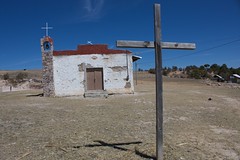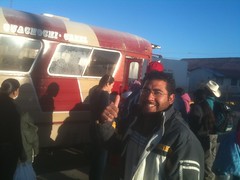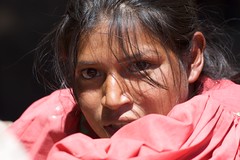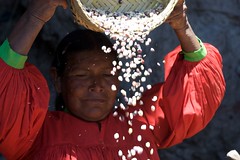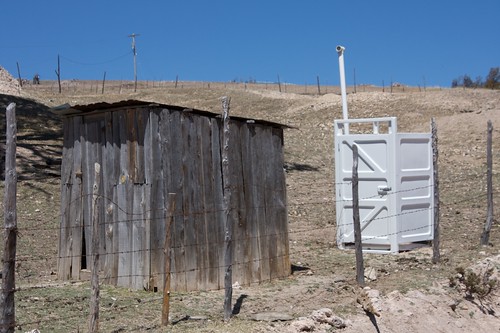On Monday we decided to go from Quírava to Batopilas. We started to walk down to the Batopilas canyon hoping that we can catch the 10 o'clock bus. After 3 hours we have descended more than 1000 m and reached the bottom of the canyon and small bridge over the Batopilas river. Finally the small minivan bus passed by, but unfortunately it was full and did not stop. After short brake at the river we decided to continue walking to Batopilas. In one hour we reached small village La Bufa and bought some water and food and found out that Batopilas is still 27 km away. It was getting late and we were already quite tired and not too well equipped. Luckily there was a pickup truck passing by and we managed to squeezed on the back. The dirt canyon road to Batopila was completed in 1977 and is very narrow and bumpy. It was the most crazy ride I have ever experienced, driving on the edge of deep canyons on the back of an old pickup with six Jehovah witnesses holding to the sides not to fly off. After an hour we have finally reached Batopilas.
The city lies at the bottom of the canyon (400 m) along the Batopila river and has tropical climate. Batopilas used to be a big silver mining town and it was the second town that has used electricity in the Mexico. There are more then 200 mines and the best times the city experienced at the end of 18th and at the beginning of the 19th century when more than 5000 people from all over the world lived there. The mines we closed in the eighties and now the town lives from drug traffic and growing marihuana and opium in the surrounding canyons. I was told that there are many mafia people who live here and that it is a very dangerous place. It was a bit strange to see nice new homes, trucks, quad motorcycles and several homes with bullet holes in their facades but I did not feel any danger.
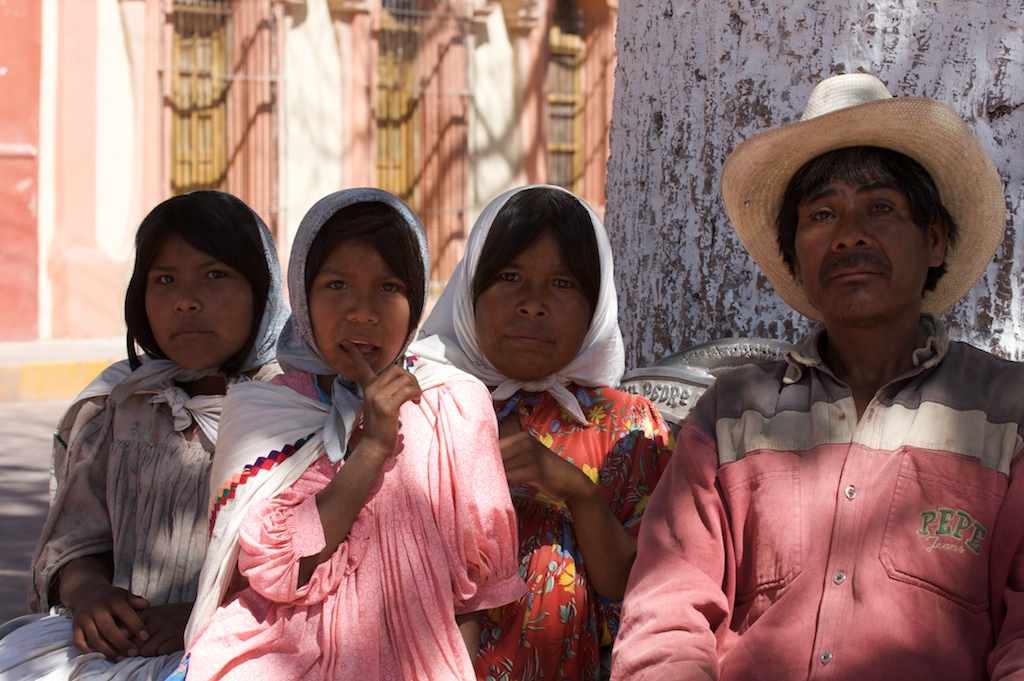 We met one german artist who has been living here for 13 years and he told us that since they build the new concrete road the local mafia kids drive very fast through the city in their new trucks. There are several hotels to offer logging for visitors who come here to see this only hidden city. Not too many tourist dare to explore the deep surrounding canyons where many drog plants are grown. We stayed over night in the local Ceranam center, which was was empty.
We met one german artist who has been living here for 13 years and he told us that since they build the new concrete road the local mafia kids drive very fast through the city in their new trucks. There are several hotels to offer logging for visitors who come here to see this only hidden city. Not too many tourist dare to explore the deep surrounding canyons where many drog plants are grown. We stayed over night in the local Ceranam center, which was was empty.
The city lies at the bottom of the canyon (400 m) along the Batopila river and has tropical climate. Batopilas used to be a big silver mining town and it was the second town that has used electricity in the Mexico. There are more then 200 mines and the best times the city experienced at the end of 18th and at the beginning of the 19th century when more than 5000 people from all over the world lived there. The mines we closed in the eighties and now the town lives from drug traffic and growing marihuana and opium in the surrounding canyons. I was told that there are many mafia people who live here and that it is a very dangerous place. It was a bit strange to see nice new homes, trucks, quad motorcycles and several homes with bullet holes in their facades but I did not feel any danger.
 We met one german artist who has been living here for 13 years and he told us that since they build the new concrete road the local mafia kids drive very fast through the city in their new trucks. There are several hotels to offer logging for visitors who come here to see this only hidden city. Not too many tourist dare to explore the deep surrounding canyons where many drog plants are grown. We stayed over night in the local Ceranam center, which was was empty.
We met one german artist who has been living here for 13 years and he told us that since they build the new concrete road the local mafia kids drive very fast through the city in their new trucks. There are several hotels to offer logging for visitors who come here to see this only hidden city. Not too many tourist dare to explore the deep surrounding canyons where many drog plants are grown. We stayed over night in the local Ceranam center, which was was empty. In the morning we took a walk along the river to the city center and visited the new museum that shows the mining history of the town. It was a day of cleaning the river and I saw many school kids picking up the trash. I crossed the famous swinging bridge and took more photos of the city.
There were not many people and I has happy to photograph few locals and one Tarahumara family at the square. I enjoyed the warm weather and took a bath the in the Batopilas river. On the way back home we drove in the medical pickup truck with 14 people and their luggage's. It was again very crazy and dusty drive but it took us only 4 hours to reach Guachochi. I was told that the local Tarahumara indians (foot runners) can go in one day from Batopilas to Quirara and back (90 km) climbing up the 1800 meters canyon. Visiting Batopilas was again a very interesting experience and I wished I could stay here longer and see the Lost cathedral that is not too far from Batopilas.
There were not many people and I has happy to photograph few locals and one Tarahumara family at the square. I enjoyed the warm weather and took a bath the in the Batopilas river. On the way back home we drove in the medical pickup truck with 14 people and their luggage's. It was again very crazy and dusty drive but it took us only 4 hours to reach Guachochi. I was told that the local Tarahumara indians (foot runners) can go in one day from Batopilas to Quirara and back (90 km) climbing up the 1800 meters canyon. Visiting Batopilas was again a very interesting experience and I wished I could stay here longer and see the Lost cathedral that is not too far from Batopilas.



